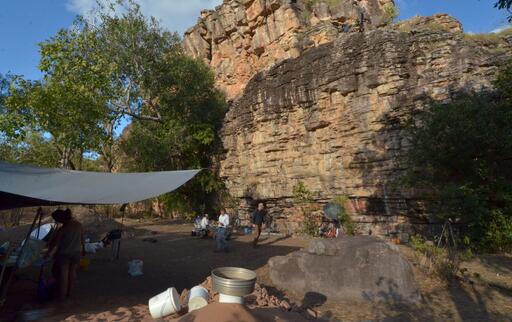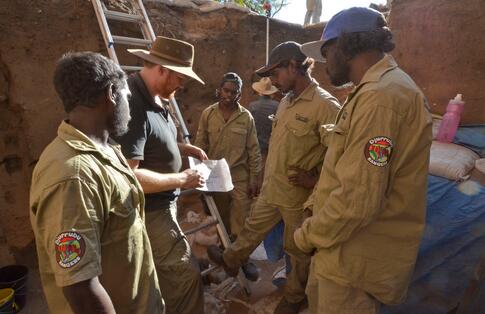65,000 years of human occupation in Australia
From:Shanghai Archaeology Forum NetWriter:Date:2017-12-10
The question of when modern humans spread out of Africa and colonised Asia, Australia and the Pacific has been an ongoing problem for generations of archaeologists that has proved difficult to solve for many reasons. Firstly, genetic analyses suggest this exodus likely took place 60-80,000 years ago – well beyond the limits of radiocarbon dating. Determining how old sites from this period are must therefore turn to alternative dating techniques, each with their own strengths and weaknesses. Secondly, many archaic species of humans likely inhabited different parts of Asia at this time, such as Denisovans, Homo Floresiensis, Neanderthals, and perhaps even Homo erectus. Thus determining which sites were made by which species is extremely difficult. Thirdly, the route modern humans must have taken to populate island southeast Asia, the combined Pleistocene landmass of Sahul (Australia and New Guinea), and the many Melanesian islands, traversed lands now deeply inundated by post-glacial sea level rise. Thus many sites from this early colonising period must lie deep under water. Finally, sites from this period generally do not preserve skeletal remains, hence the makers of stone tools and other items remains enigmatic.
Australia is an extremely valuable region of the world for understanding this story of modern human dispersal for a number of reasons. Firstly, there were never any archaic humans living in this region, hence the oldest traces of occupation must attest to the first arrival of modern humans at the end point of the long journey out of Africa. Secondly, to reach Australia and New Guinea ocean crossings of at least 65km in length were required, necessitating ocean-going vessels capable of carrying many people and abundant supplies. Thirdly, Australia is the driest continent on earth and home to a unique flora and fauna, necessitating dramatic adaptations to exploit new resources and adopting new settlement and subsistence strategies. Finally, genetic analyses indicate that Australian Aborigines have remained largely isolated since first colonisation, hence cultural and technological changes on this landmass must have taken place independently of those elsewhere.
Our research aimed to determine when modern humans first reached Australia, by returning to the site of Madjedbebe (formerly known as Malakunanja II) and to undertake state-of-the-art excavations using appropriate dating techniques that can stretch beyond the radiocarbon barrier. Our team consisted of lithic specialists, luminescence dating experts, geoarchaeologists, usewear and residue experts, radiocarbon dating experts, anthracologists, archaeobotanists, archaeozoologists, malacologists, geomorphologists and palaeoclimate experts.

In 2012 and again in 2015, we excavated to 3.5m depth in two lengthy field-seasons. The results are globally significant because they have completely changed our understanding of the timing and nature of the first human occupation of Australia and the region more generally. Our results enhance our scientific appreciation of the initial dispersal of modern humans out of Africa and across Asia to the edge of the Pacific. The analysis of excavated material consisted of three major components. The first saw one of the most comprehensive combined luminescence and radiocarbon dating programs ever undertaken in the region, with ages determined for 24,800 sand grains from 54 samples and 50 AMS radiocarbon dates. A new baseline age for human occupation was established at 65,000 +/-5000 years, pushing back the age of modern human occupation in the region by at least 15,000 years. Second, extensive studies were undertaken to ascertain the structural integrity of the site, including refitting of stone tools, assessments of burning and associated hearths, and thin-section analysis of bulk sediment blocks to establish the presence of past occupation surfaces and subsequent disturbance. This multi-pronged investigation revealed the site was not significantly disturbed and that occupation deposits were not overly affected by post-depositional processes. Third, analysis of the remarkable finds from the site demonstrated that the first modern humans to enter the region employed stone tools that were highly sophisticated for the time and engaged in artistic practices not known before from this period. The site contains the oldest known stone axes in the world, the first use of seed-grinding grindstones in the region, and the oldest examples known in the region of pigment processing and admixture of reflective mica paint additives to make reflective paints.

In partnership with the local Mirarr Aboriginal traditional owners of the site, the research was published in Nature in July 2017 and received extensive global media attention and extensive television coverage. It demonstrates the profound antiquity of modern human occupation of Australia and expands our understanding of early technological capabilities, such as open-ocean crossings and the behavioural flexibility required to establish a viable human population in the unique Australian environment.

